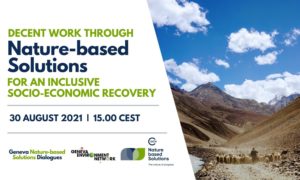Event Virtual
Decent Work Through Nature-based Solution for an Inclusive Socio-Economic Recovery | Geneva Nature-based Solutions Dialogues
The Geneva Nature-based Solutions dialogues aim to facilitate further engagement and discussion among the stakeholders in International Geneva and beyond, in the lead-up to a critical year for nature and society. The dialogues are convened by the Geneva Environment Network and the International Union for Conservation of Nature (IUCN).
About the Dialogues
We are facing a triple planetary crisis – climate change, nature loss and pollution. In this context, Nature-based Solutions (NbS) are a powerful ally to address a societal and environmental challenges. As per IUCN definition, NbS are actions to protect, sustainably manage and restore natural or modified ecosystems that address societal challenges effectively and adaptively, simultaneously providing human well-being and biodiversity benefits.
NbS are a powerful tool to facilitate and catalyse the engagement of cross-sectoral stakeholders to join forces towards the implementation of an ambitious Post-2020 Global Biodiversity Framework (GBF) and move towards achieving the CBD 2050 Vision of ‘Living in harmony with nature’. NbS also offer a pathway for synergies among several multilateral environmental agreements, including for biological diversity (CBD), climate change (UNFCCC), disaster risk reduction (Sendai Framework), desertification (UNCCD) and the wider Sustainable Development Goals (SDGs) – and for mainstreaming nature conservation into sectoral decision-making processes.
In the lead-up to a critical year for nature and society, NbS offer an opportunity to address a wide range of urgent societal challenges. The year 2021 and the major upcoming negotiations should indeed mark a turning point towards a resilient world for future generations.
Join the Geneva Environment Network and the International Union for Conservation of Nature in a one-year journey, where experts from all over the world and different sectors will discuss throughout the year how NbS are relevant to various debates ongoing in Geneva.
About this Session
As countries are addressing the economic impacts of COVID-19 by allocating trillions of dollars to fiscal stimulus packages and beginning to develop longer-term economic recovery programs, a shift towards nature-based systems is more urgent to ensure that sustainable decent jobs are created to build resilience. Governments, employers’ and workers’ organizations have a key role in seizing this opportunity and paving the way to a socially just, but also resilient and green recovery. Thus, building forward better, creating pathways to resilience and sustainable development that leave no one behind.
2021 brings numerous opportunities for multilateral global action, to support the emergence of nature-focused economic activity. At its last session, in July 2021, the G20 environment ministers explicitly mentioned the need to harness the power of Nature-based Solutions or Ecosystem-based Approaches to address biodiversity loss, restore degraded land, boost resilience, mitigate and adapt to climate change, while providing multiple benefits across the economic, social, and environmental domains. They also recognized the need of scaling up and implementing Nature-based Solutions or Ecosystem-based Approaches in key sectors of our societies and economies, and across all ecosystems including urban areas. Equally, in the G20 Development Ministerial Meeting and Ministerial Event on Humanitarian Assistance in June 2021, they confirmed that their efforts aim at a strong recovery that is inclusive, resilient and socially, economically and environmentally sustainable, stressing the empowerment of women and youth. They underscored the importance of quality infrastructure that contributes to the localisation of the SDGs, fostering in particular local employment and local environmental protection, not to mention the creation of decent jobs.
This session looked at the vital role played by ecosystems in supporting employment. Indeed, 1.2 billion jobs in sectors such as farming, fisheries, forestry, and tourism are dependent on the effective management and sustainability of healthy ecosystems. It is also estimated that half of the world’s Gross Domestic Product (GDP) is dependent on nature. It will also look at the substantial opportunities for job creation through ecosystem restoration and the use of NbS.
ILO’s Green Works, which applies an employment-intensive approach, creates additional and productive jobs using innovative and appropriate technologies to develop and maintain infrastructure, environmental and community assets. The approaches enhance social and environmental impacts of investments, contribute to disaster risk reduction and support much needed livelihoods. As such, Green Works can broaden the impact of nature-based solutions by addressing both working poverty and unemployment and environmental degradation simultaneously.
Sessions
- Nature-based Solutions and Health | 26 April
- Nature-based Solutions and Ecosystems Restoration | 7 June
- Nature-based Solutions and the Post-2020 Biodiversity Framework | 28 June
- Nature-based Solutions and Food | 13 September
- Nature-based Solutions and Oceans | 27 September
- Nature-based Solutions for Building Resilience | 11 October
- Nature-based Solutions and Cities | 25 October
- Nature-based Solutions and Peacebuilding | 1 November
- Nature-based Solutions and Water | 22 November
- Nature-based Solutions and People | 6 December
Speakers
By order of intervention

Juha SIIKAMÄKI
Chief Economist, IUCN

Mito TSUKAMOTO
Head of the Development and Investment (DEVINVEST) Branch, ILO

Anne Moise MARCELIN
Vice-Consul, Ministry of Foreign Affairs and Cults, Haiti

Martha Imaculada de ARAÚJO EFI
Baikeno ethnic minority leader, Timor Leste

Jonelle SIMUNICH
Senior Strategist, Foresight, ARUP
Summary
Welcome
Setting the Scene
Juha SIIKAMÄKI | Chief Economist, IUCN
- Nature-based Solutions are defined as actions to address societal challenges for protection, sustainable management, and the restoration of ecosystems in a way that benefits ecosystems and human communities. NbS uses nature and ecosystems as natural infrastructure that supports and provides benefits for society and the environment.
- Often discussed in the framework of disaster risk-reduction strategies, but they have a potential to encompass other important aspects such as health, food and water security, and biodiversity loss. Apart from the long-term benefits of NbS, short-term benefits are also available at the moment, particularly in recovering from the COVID-19 pandemic.
- Implementing NbS in a robust and sustainable manner at a greater scale has never been more important. As such, the IUCN has developed the Global Standards for NbS to these solutions can be evaluated on a specific and clear set of criteria, including, environmental, economic, and social.
- The economic consequences of the COVID-19 pandemic has been severe, and are foreseen to last over the next several years. Almost all countries are forecasted to have a lower economic output over the next few years, with variation across the different countries.
- On the other hand, the responses to this have also been unprecedented, that have reached at least USD 17 trillion. However, a vast majority at 80% of this come from advanced economies, while developing countries, especially low-income countries who have been struggling even before the pandemic, will have a much difficult time to recover.
- Ensuring that the economic recovery is sustainable, green, and replicable as much is possible, has been recognized globally. However, though green spending has increased over time, it remains low in comparison with the whole of recovery spending, and has only focused mostly on greenhouse gas mitigation thus far.
- What can be done to have nature play a bigger part in this?
- In addressing the loss of jobs in the COVID-19, for example, we look to evidence from Central America, where ecosystem restoration activities can create jobs on an even greater scale at a per million dollar investment, compared to other sectors.
- Not all investments can create jobs in a similar fashion. In Central America, productive landscape restoration and mangrove restoration have been more productive in both implementation and maintenance phases.
- They also have the potential to benefit more vulnerable groups. In Rwanda, landscape restoration benefitted women roughly equally to men. Women gained 49% of the short-term jobs and 46% of the long-term jobs.
- Job creation is also dependent on the techniques employed: restoration can either be manual or mechanized. Because manual restoration employs more on a per-hectare basis, countries implementing NbS opt for manual restoration.
- Restoration and conservation are not created only with jobs in mind. But this is the benefit of NbS: they have the distinct advantage of addressing multiple societal issues at once, from mitigating effects of climate change to achieving SDGs.
Current Developments and Opportunities on NbS in the World of Work
Mito TSUKAMOTO | Head of the Development and Investment (DEVINVEST) Branch, ILO
- Background: COVID-19 has caused an unprecedented and massive amount of job losses around the world. Developing countries have lost 10.6% of working hours, or 120 million full-time jobs. The consequent fall in labor income of 12% has been distributed unevenly, causing an increase in inequality among countries, in addition to the insufficient fiscal space, weak social protection systems, and large numbers of informal workers that developing countries experience even before the pandemic. It is critical then that investments, employment, and social protection do not fall back to what they were then.
Three key messages:
- Many economic activities and jobs are directly dependent on nature and the ecosystem services they provide. ILO estimates this to be the case for 1.2 billion jobs globally, around 40% of total employment. For sectors that are more nature-dependent (agriculture, forestry, fisheries, water and tourism), NbS can improve both productivity and sustainability of jobs that affect each other positively. This means that the opposite is also true, if business goes as usual, the environment, jobs, and economic activity also disappear.
- Many activities that are intrinsic to NbS are also employment-intensive by nature, where they can also be done in a cost-effective manner while maintaining a high-level of quality. Using employment-intensive investment approaches in the environment can increase labor intensity by 35%. It’s possible to maximize employment intensity, or use an optimal mix of capital and labor, or both, and still have the expected outcomes, whether they be in reforestation, soil and water conservation, agroforestry, control and removal of invasive species and urban greening. Intensive employment green works can create a triple win of an economic, social, and environmental benefits: providing much-needed jobs, creating decent work through proper wage and labor practices, and protecting and rehabilitating nature.
- NbS and jobs are also attractive to women and youth. Youth are more motivated to work for environment-related jobs, while investing for their future, while environment-related jobs tend to be more attractive to women, in comparison to construction and infrastructure work, which are often male-dominated. Stimulus and investments focused on NbS and green works can be designed to provide more jobs for women and jobs. These can also be used as responses to two major challenges of our time: first with climate change adaptation and a just transition, and second with unemployment, potentially addressing full employment, an ILO Convention 122, and Recommendation 205, Unemployment and Decent Work for Peace and Resilience.
- The ILO has been working on these through Employment Intensive Investment Programs (EIIP) in the environmental sector since the 1970s. These guide, assist and guide the identification and design, and implementation of green works, interventions advocating for better use of NbS, and seeking opportunities for capacity-building of communities. The environment can not only create jobs, but create decent ones.
Anne Moise MARCELIN | Vice-Consul, Ministry of Foreign Affairs and Cults, Haiti
- Bringing the perspectives from a country that has benefitted from NbS. Haiti, like all Carribean countries are exposed to hurricane, risks, and natural disasters. Today, it faces deforestation, pollution, and loss of biological diversity. Now, we add earthquakes and hurricanes, bringing loss of human life, materials poverty, and more.
- In 2008, Hurricane Hanna hit Gonaïves City forcing the government to declare a state of emergency. The ILO with the Ministry of Planning in Haiti and other associations began to fix certain areas of the city and restore the city. One of the ways was to have the various interventions that create employment, whose objectives were to implement a watershed, manage and reduce effects of natural disasters, rehabilitate the weakened environment, and soil and water conservation through labor-intensive jobs.
- NbS included implementation of stone walls, reforestation of plants and trees at 315 hectares of reforestation, with the formation of associations of men and women. These programs really worked. After 12 years, the effects continue to be felt, as they continue to plant more trees and protect the area.
- In areas affected by recent natural disasters, it is not far off to have similar programs to be implemented there, as local materials are available and work still has to be done. There will always be hurricanes, but the data from the ILO shows that such programs do work, showing communities how protecting the environment can also protect themselves.
Martha Imaculada de ARAÚJO EFI | Baikeno ethnic minority leader, Timor Leste
- She designed traditional and sustainable houses using local materials in Timor Leste that can respond to both climate change and owner necessity. Though it won a competition, the design remained a design, and did not get proper financial and technical support to implement these.
- Rural people face economic limitation and isolation, where they are far from the city to obtain the standard construction materials. People who live in rural areas therefore still build with local materials from nature. They know their local materials well: they choose based on their durability, how easy they are to work with, and does not require heavy equipment for construction — an already existing nature-based solution.
- She is currently helping develop and promote these with the ILO. Hopefully, with youth’s creativity and active participation in helping develop sustainable local solutions, and the support for their initiatives, it can help young indigenous professionals, especially women, across the world.
Jonelle SIMUNICH | Senior Strategist, Foresight, ARUP
- Many of the solutions already discussed today can be facilitated by, supported by, and scaled-up by cities, infrastructure and different types of design, from reforestation, using new, sustainable materials to respecting waterways and wetland conservation.
- In charge of foresight at ARUP, they are looking to cities as solutions to drive nature-positive outcomes, as they are economic engines which are intrinsically linked to and feed into the environment that may be very distant.
- With NbS, we need to think of cities as both retro-fitting and newly-built ones, which require us to have a fundamental rethink of our systems, from new skills, new knowledge and new services, we will be needing sourcing-conscious creators and builders, skilled green labor, educators and advocates, to policymakers and environmental experts, among others.
Juha SIIKAMÄKI | Chief Economist, IUCN
- It has been noted that a lot of developing countries are highly-dependent on nature and natural resources. One immediate challenge we see within the context of the pandemic is that even though countries have been keen on investing in Nature-based Recovery, many of them don’t have the fiscal space to take action on it. In these situations, it is understandable that it is extremely difficult for these countries to invest on these solutions. Even then, these countries have high potential for implementing NbS, and they continue to include NbS into their national action plans, for example.
- Here, there is a need to address other problems as well, from the debt distress to climate change and conservation. In these triple crises, we find a certain alignment among certain countries in South and Central America, Africa and Southeast Asia, where they need economic investment, address environmental problems through nature conservation investments which are underinvested in globally, and are already committed to including these in their national plans. With the right opportunities, NbS can therefore address not only the short-term but also the long-term.
Open Discussion
Q. The IUCN and the ILO are soon going to sign a Memorandum of Understanding that can assist developing countries. Would you be able to elaborate on this?
TSUKAMOTO: The intention is to bring the best of both worlds. Within the socio-economic recovery of countries in light of COVID-19, the impact of jobs has been so significant, that we need to immediately address the need for jobs in order to recover. On the other hand, the environmental aspect is that there are opportunities to have green works wherein you’re not only addressing targetted populations affected by environmental degradation and social vulnerabilities, but using local-based approaches as Martha had mentioned, by involving indigenous and other local communities that can help identify already existing NbS.
The reason why we’ve moved into thinking about green works, our focus often falls upon infrastructure, from restoring watersheds to reforestation. The question is then, what are the local materials being used? Are these the best materials to be used? There is always a balance that has to be struck. The local resource-based approach has the intention of creating much larger multipliers in the local economy. In Anne Moise’s presentation, these are remote areas, but working with local materials alongside having the right tools to build more sustainable infrastructure can be something that can help the community.
Ensuring that these ILO programs are cost-effective and quality-assured, it’s been around since the 70s. The program that Anne-Moise described was one that started out as an emergency intervention, and then became climate resilient. The amazing thing is to see the infrastructure 13 years earlier was still there. The impact of the shed could still be felt with having less impact from natural disasters. cooperatives still existing to this day, and plants still being planted. The importance of the MOU with IUCN is to bring the expertise together, to bring out the argument for the need for more environmentally conscious activities.
We do work with governments in designing possible interventions that are more employment intesive in one sector than the other. We are also working with IFIs to look into assessing employment impacts in different sectors, potentially helping create a narrative that can show why these can help not only the environment but the economy and society at large.
Q. How can training institutions accelerate these movements?
TSUKAMOTO: Since the 1980s, the ILO has worked with at least 8 chantier écoles or national labor-based institutions in Africa with the intention of bringing labor-based training opportunities to communities and develop capacities. It’s important as these ensure that institutions are able to replicate these technologies and capacities. Martha’s example of indigenous tech is also being worked on in ILO.
Q. What is the business perspective on nature-based solutions and job creations?
SIMUNICH: It really depends on the business. For some, it’s really the way forward in a way that we need to rethink how we design, build, and operate cities. These are opportunities to drive change.
Closing Remarks
SIIKAMÄKI: It is disheartening to hear that the recovery is not just about the pandemic, but as well as the hurricanes and earthquake. I send out my best wishes and support to the country.
In terms of the last question on the link between jobs and NbS, there are two points:
- IUCN is committed to finding ways into incorporating nature into economic recovery plans. As an indication, IUCN Director General Bruno Oberle has initiated a nature-based economic recovery initiative, to provide a evidence-based knowledge to understand the need and possibilities of including nature-based solutions into recovery packages, and to make sure that nature gets a much larger share in economic recovery efforts, not just avoiding environmental harm in the path towards recovery, but to have 10% of total recovery investment go into nature. It’s a high-level target, but IUCN is working with countries and the local level so that the opportunity is not missed.
- On the other hand, after having been postponed twice, IUCN World Congress is coming up, where we discuss the latest issues related to the conservation of nature. Much of the plenaries here are focused on nature-based recovery, led and joined by experts, international agencies, national leaders, civil society members, youth and indigenous representatives. Our goal is to ask participants, “What is it we can do? What is it that can be done?” that allows to help both nature and economic recovery.
TSUKAMOTO: When we’re looking at employment-based activities, one needs to step back to think, “What are the best alternative solutions that exist that can be nature-based or can act as alternatives to the kind of activities that we already do?” The environment has a huge potential to create decent job opportunities, create livelihoods that target the most vulnerable population, and to strengthen national and local institutions by making these interventions more inclusive and sustainable.
Moving towards more Nature-based Solutions needs to also be about ensuring sustainable, human centered, and inclusive decent jobs. – Mito TSUKAMOTO
Video
In addition to the live WebEx and Facebook transmissions, the video will be available on this webpage.
Documents
Links
Here are some relevant information to understand the potential of Nature-based Solutions in addressing :
- What are Nature-based Solutions (NbS)? | Infographic | IUCN
- Nature-based Solutions | Wednesdays for the Planet | GEN | 28 April 2021
- Ensuring effective Nature-based Solutions | IUCN | July 2020
- Nature-based recovery | IUCN | April 2021
- Nature Hires: How Nature-based Solutions can power a green jobs recovery | ILO & WWF | October 2020
- COVID-19 response and recovery: Nature-Based Solutions for People, Planet and Prosperity | Global Goal for Nature Group | 9 November 2020
The update on Nature-based Solutions provides more information and the most recent resources, news and articles from the various organizations in international Geneva and other institutions around the world.

